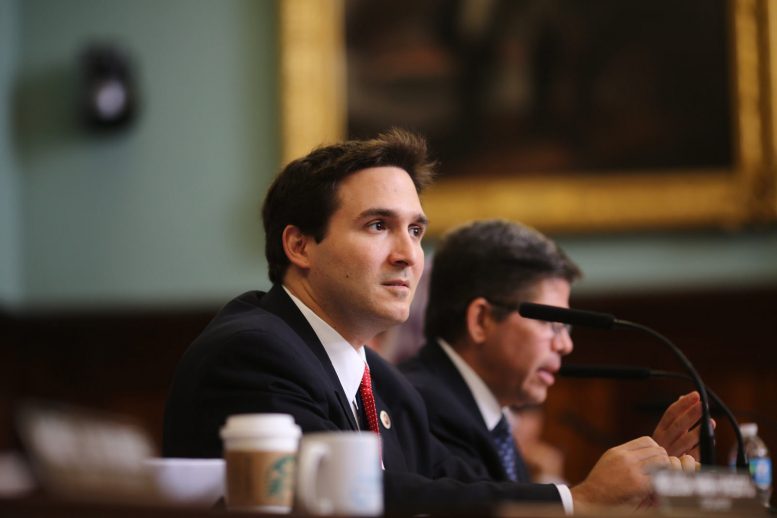The City Council is trying to drag the Board of Standards and Appeals—the agency that decides zoning changes for many New York City developments—into the 21st century. The council’s Government Operations committee spent yesterday afternoon discussing bills that would force the agency to post zoning applications and decisions publicly, create a map of those decisions, and keep community boards and council members in the loop on applications.
The Board of Standards and Appeals consists of five commissioners appointed by the mayor. City law requires that the board must include one registered architect, one professional engineer, and one urban planner. While many pieces of the city’s land use process can be obscure, the BSA has steadfastly resisted oversight and transparency. Every year, dozens of developers file applications with the agency, seeking a minor change or exemption from zoning rules based on a “financial hardship.”
Essentially, owners must prove that land use rules or the shape of their property will prevent them from generating enough revenue to justify the cost of construction and purchasing a site. Often, developers and architects want to be able to build a project that’s taller or differently shaped than zoning will allow. In order to get approval from the BSA, they have to present financial projections and a design that show why they need to build that extra space, whether it’s for apartments, offices, or amenity space. Once the board has reviewed an application and deemed it complete, they schedule a review session and public hearing for the project. Both the review session and hearing are open to the public, but public testimony is only allowed at the hearing.
Council members and community boards often feel like they aren’t given notice about applications, or that the board doesn’t listen to their input. “We’ve been plagued by BSA rulings that went against the wishes of civic organizations in the neighborhood,” said Councilman Jimmy Van Bramer, who represents western Queens. “We were inspired by a building on Woodside Avenue where we knew that the project was inappropriate and out of scale for the neighborhood. Every single official wrote the BSA and, in one voice, said that this was wrong for our community, and yet the BSA ruled that this was appropriate.”
Consequently, the package of 10 bills on the table yesterday would require the BSA to offer written explanations for how it makes its decisions, to notify council members about each application, and to post applications on its website. Right now, developers are responsible for sending applications to community boards, elected officials, and the Department of City Planning.
Ryan Singer, executive director of the BSA, claimed that he didn’t want to burden the board’s 12 staffers with a task that’s currently handled by applicants. And the board couldn’t post applications online “for security reasons,” he argued, but people can file a freedom of information law request or visit their local community board or city council offices to review applications. It’s hard to believe building plans and environmental reviews are too sensitive to post on a city website, when several other agencies do just that. And many BSA applications ultimately go through the city’s public review process. In that case, the Department of City Planning posts the full proposal online.
Officials often worry that the board simply rubber stamps decisions, but Singer argued that wasn’t true. Last year, they reviewed 96 pre-application proposals, but only 27 made it to the formal application and approval process. Plans that don’t meet the BSA’s rigorous standards for financial hardship typically die in the pre-application phase.
Another bill will require the board to post all of the public testimony and written comments that it receives online. The BSA would also have to create and post on its website an interactive map of all the properties affected by its decisions. Singer said he lacked the staff and funding to launch a map. In reality, the agency would only have to send a list of blocks, lots, and decisions to the city’s IT department, which would then add the info to the main land use map, ZoLA, according to the bill’s sponsor, Manhattan council member Ben Kallos. Singer said he would be open to discussing that option with the council.
Under this legislation, a developer would have to pay a $25,000 fine for lying to the Board of Standards and Appeals. The Council also wants the board to hire a real estate appraiser to fact check applicant’s financial hardship claims. In contrast, Singer seemed amenable to both these proposals, as long as they wouldn’t stretch his small staff.
Subscribe to YIMBY’s daily e-mail
Follow YIMBYgram for real-time photo updates
Like YIMBY on Facebook
Follow YIMBY’s Twitter for the latest in YIMBYnews


The BSA has become a back-door way for developers to totally ignore residential zoning rules. Under deBlasio the BSA has become a backdoor way to sneak high-density developments into low-density zoned neighborhoods.
To the letter legitimacy must come first and, lessen the classes of part on dangers decisions let.